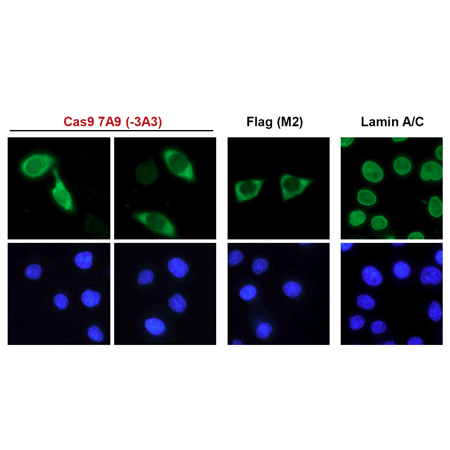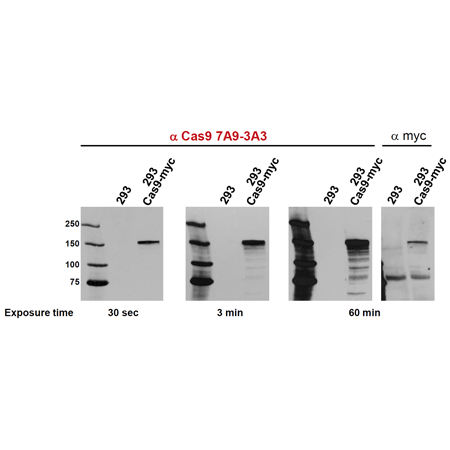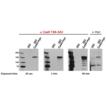| Alternative Name: | CRISPR-associated endonuclease Cas9/Csn1, CRISPR associated protein 9, SpyCas9 |
| |
| Clone: | 7A9 |
| |
| Host: | Mouse |
| |
| Isotype: | IgG1κ |
| |
| Immunogen: | N-terminal fragment of Streptococcus pyogenes Cas9. |
| |
| UniProt ID: | Q99ZW2 |
| |
| Source: | Purified from mouse ascites. |
| |
| Specificity: | Recognizes both Cas9 and dCas9 (nuclease deficient Cas9). |
| |
| Applications: | IF, IP, WB
|
| |
| Recommended Dilutions/Conditions: | Immunofluorescence (1:500-1:2,000)
Immunoprecipitation (1:20)
Western Blot (1:1,000)
Optimal conditions must be determined individually for each application. |
| |
| Purity Detail: | Protein G affinity purified. |
| |
| Formulation: | Liquid. In PBS containing 0.02% sodium azide. |
| |
| Handling: | Avoid freeze/thaw cycles. |
| |
| Shipping: | Blue Ice |
| |
| Long Term Storage: | -20°C |
| |
| Scientific Background: | Cas9 (CRISPR associated protein 9) is an RNA-guided DNA endonuclease enzyme associated with the CRISPR (Clustered Regularly Interspersed Palindromic Repeats) adaptive immunity system in Streptococcus pyogenes and other bacteria. Cas9 is used to interrogate and cleave foreign DNA, such as invading bacteriophage DNA or plasmid DNA. This is accomplished by unwinding foreign DNA and checking for if it is complementary to the 20 base pair spacer region of the guide RNA. If the DNA substrate is complementary to the guide RNA, Cas9 cleaves the invading DNA.
Cas9 is becoming a prominent tool in the field of genome editing because it can cleave nearly any sequence complementary to the guide RNA. Because the target specificity of Cas9 stems from the guide RNA, engineering Cas9 to target new DNA is straightforward, and versions of Cas9 that bind but do not cleave cognate DNA can be used to control transcriptional activation and repression. |
| |
| Regulatory Status: | RUO - Research Use Only |
| |

Figure 3. Immunoprecipitation. HEK293T cells expressing N-terminally Flag-tagged S. pyogenes Cas9 were lysed 72 hours post transfection by resuspending the cells in Hunt buffer and subjecting them to three freeze-thaw cycles in liquid nitrogen/on ice. Proteins were immunoprecipitated from 100 μg of whole cell lysate either for 1 hour at 4°C with crude Cas9 clone 7A9 cell culture supernatant (IgG concentration n.d., lane 3) followed by incubation for 1 hour at 4°C with a 1:1 mixture of protein A/G sepharose beads, or for 2 hours at 4°C with Cas9 clone 7A9 monoclonal antibody crosslinked to a 1:1 mixture of protein A/G sepharose beads. Beads were washed two times with Hunt buffer and once with TBS. Bound proteins were eluted by boiling in Laemmli buffer, separated by 7.5% SDS-PAGE and transfered to nitrocellulose. Membranes were blocked in 3% dry milk (NFDM) in PBS-Tween for 1 h at RT and incubated with Cas9 7A9 monoclonal antibody diluted in 0.5% NFDM in PBS-T for 1 hour at RT, followed by incubation with HRP-coupled anti-mouse antibody. Proteins were visualized by ECL. Asterisk indicates IgG heavy chain.

Figure 2. Immunofluorescence analysis. Hela cells were transiently transfected with an N-terminally Flag-tagged S. pyogenes Cas9 expression vector. 48 hours post transfection cells were fixed in 3.7% formaldehyde, permeabilized in 0.5% Triton-X and blocked in 2% BSA in PBS for 2 hours at RT. Cells were stained with the indicated antibodies at 4C o/n, followed by incubation with anti mouse-AF488 coupled secondary antibody for 1 h at RT. Nuclei were counter-stained with Hoechst 33342. Images were taken with an Axiovert 135 TV fluorescence microscope. For presentation purposes, images were adjusted for brightness and contrast.

Figure 1. Western blot. HEK293 cells were transiently transfected with pMLM3613myc and lysed in hot Laemmli buffer 40 hours post transfection. Proteins were separated by 7.5% SDS-PAGE and transfered to nitrocellulose. Membranes were blocked in 3% dry milk (NFDM) in PBS-Tween for 1 h at RT and incubated with the indicated antibodies diluted in 0.5% NFDM in PBS-T for 2 hours at RT, followed by incubation with HRP-coupled anti-mouse antibody together with antiBLUE protein marker antibody for 1 hour at RT. Proteins were visualized by ECL.














